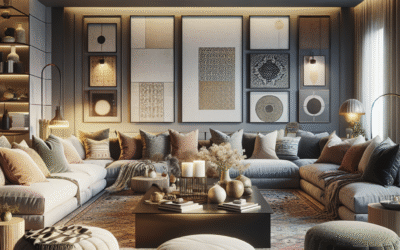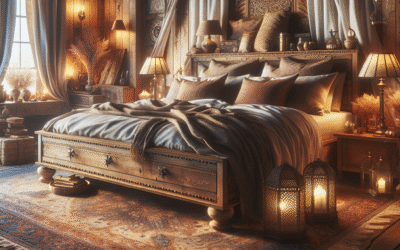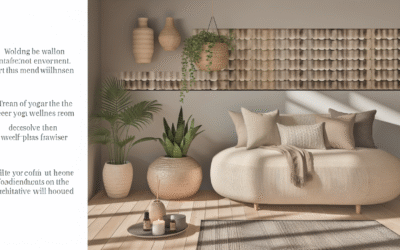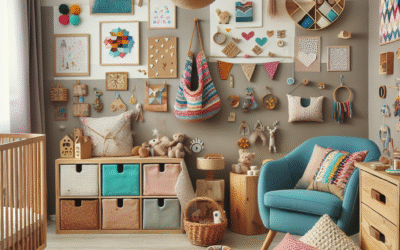
The Aesthetic Impact of Runner Rugs in Art Galleries: A How-To Guide
Art galleries are more than just spaces for displaying art; they are meticulously crafted environments designed to enhance the viewing experience and evoke specific emotions. Every detail, from lighting to wall color, plays a crucial role. Yet, one element often overlooked, or perhaps underestimated, is the humble runner rug. Runner rugs in art galleries are not merely decorative accents; they are powerful tools that can profoundly influence the aesthetic, acoustic, and even navigational flow of a space. Imagine walking through an expansive gallery, the click of your shoes echoing, or feeling a sense of disconnect between disparate exhibits. A well-chosen runner rug can solve these issues, adding texture, warmth, and a visual pathway that subtly guides visitors through the artistic narrative.
This comprehensive guide delves into how these versatile textile elements can transform an art gallery. We will explore the nuanced ways runner rugs can enhance the viewing experience, improve acoustics, define zones, and even contribute to the preservation of the art itself. From selecting the right materials and patterns to strategic placement and maintenance, you’ll gain actionable insights to leverage the full potential of runner rugs in any gallery setting. Prepare to discover how these long, narrow textiles can elevate the exhibition space, creating an environment where art truly thrives and visitors feel an immersive connection.
Understanding the Transformative Power of Runner Rugs in Gallery Spaces
The role of runner rugs extends far beyond simple floor covering. In art galleries, they serve multiple functions that contribute to both the practical operation and the overall artistic atmosphere. Understanding these functions is the first step in harnessing their full aesthetic impact. Think of them as silent curators, subtly influencing how art is perceived.
Enhancing Visual Flow and Direction
A primary function of runner rugs is their ability to guide the eye and direct foot traffic. Their linear form naturally creates a pathway, leading visitors from one exhibit to the next. This is particularly effective in large, open spaces where a clear route might not be immediately obvious. A well-placed runner rug can:
- Create a narrative journey: Connect different thematic sections of an exhibition, making the transition seamless.
- Highlight specific artworks: Draw attention to a key piece, leading the viewer directly towards it without imposing.
- Break up vast spaces: Prevent a gallery from feeling overwhelming by dividing it into more digestible visual segments.
This visual guidance ensures that visitors engage with the exhibition as intended, deepening their appreciation for the curatorial vision.
Acoustic Improvements: Muting the Gallery Echo
Art galleries, with their high ceilings and hard surfaces (concrete, wood, glass), are notorious for poor acoustics. The echo of footsteps, hushed conversations, and even the rustle of clothing can distract from the quiet contemplation necessary for appreciating art. Runner rugs, especially those made from dense, natural fibers, act as excellent sound absorbers.
- Reduce reverberation: Softer surfaces absorb sound waves, preventing them from bouncing endlessly around the room.
- Dampen foot traffic noise: The clatter of shoes on hard floors is significantly muffled, creating a more serene environment.
- Improve audibility of discussions: For guided tours or quiet conversations, a calmer soundscape allows voices to carry without excessive echo.
A quieter gallery space allows visitors to focus more intensely on the artworks, fostering a deeper, more intimate experience.
Adding Texture, Warmth, and inviting Ambiance
Hard-edged gallery spaces can sometimes feel stark, cold, or even intimidating. A runner rug introduces an essential element of softness and warmth. Visually, its texture can contrast beautifully with smooth walls and polished floors, adding a layer of sophisticated complexity.
- Introduce visual interest: A rug’s pattern and color can provide a break from monotonous surfaces, becoming an artwork in itself.
- Create a welcoming atmosphere: Textiles inherently feel more inviting than hard surfaces, encouraging visitors to linger.
- Ground the space: Provide a tactile connection to the floor, making large rooms feel more intimate and less daunting.
This added warmth and texture can significantly impact how comfortable and engaged visitors feel within the space.
Selecting the Perfect Runner Rug for Your Art Gallery
Choosing the right runner rug involves a delicate balance of aesthetics, functionality, and practicality. It’s not just about what looks good, but what performs best in a high-traffic, art-centric environment.
Material Matters: Durability, Acoustics, and Aesthetics
The choice of material dictates a rug’s durability, maintenance, and acoustic properties. For a gallery, resilience is key. Consider these options:
- Wool: Highly durable, naturally stain-resistant, excellent insulation, and superior sound absorption. Wool rugs age gracefully and contribute a luxurious feel. They are a classic choice for high-end galleries.
- Nylon: Extremely resilient, tough against wear and tear, and easy to clean. Often used in commercial settings. Synthetic, but can mimic natural fibers well.
- Polypropylene (Olefin): More budget-friendly, good stain resistance, and fairly durable. Lacks the luxurious feel of wool but offers practicality.
- Natural Fibers (Jute, Sisal, Seaweed): Provide unique textures and an organic feel. While durable, they can be less soft underfoot and might show wear more readily in very high-traffic areas. They contribute excellent acoustic dampening.
For optimal performance in a gallery, a blend (e.g., wool-nylon) can offer the best of both worlds: the beauty and acoustic benefits of natural fiber with the enhanced durability of synthetics.
Pattern and Color: Complementing, Not Competing, with Art
The runner rug should enhance the art, not distract from it. This means careful consideration of pattern and color.
- Subtle Patterns: Geometric patterns, tone-on-tone designs, or muted textures are generally preferred. Intricate, busy patterns can draw too much attention away from the artworks.
- Neutral Color Palette: Greys, beiges, creams, and earthy tones provide a sophisticated backdrop that allows the colors of the art to pop. Deep jewel tones can work in specific contexts, but require careful matching.
- Consider the Art Style:
- For contemporary, minimalist art, a solid-colored or subtly textured rug maintains a clean aesthetic.
- For classical or traditional art, a rug with a rich, subdued pattern (like Persian or Oriental styles, but in muted colors) can add a sense of historical context and gravitas.
- Emotional Impact of Color: Cool tones (blues, greens) can create a serene, contemplative mood, while warmer tones (reds, oranges) might evoke energy or passion. Align this with the desired gallery atmosphere.
The goal is harmony; the rug should feel integrated, not imposed.
Size and Length: Proportionality and Purpose
Runner rugs are designed for length, extending through hallways or bridging spaces.
- Length: It should span most, if not all, of the intended pathway. Avoid using multiple short runners unless there’s a distinct break in the path or a specific design reason. A continuous runner creates a more seamless flow.
- Width: The runner should be wide enough to feel substantial but leave adequate floor space on either side. A common guideline is to leave at least 6-12 inches of exposed floor on both sides of the runner for visual balance. In a gallery, this allows the original flooring to act as a frame for the rug and defines the path clearly.
- Proportionality: Ensure the rug’s dimensions are proportionate to the scale of the room and the artworks. A tiny rug in a vast hall will look lost; an overly wide rug can feel like wall-to-wall carpeting.
Measurement is critical for a polished look. Don’t guess.
Strategic Placement: Maximizing Aesthetic & Functional Impact
Once you’ve selected your runner rugs, their placement is paramount to achieving the desired effect. It’s about more than just laying them down; it’s about intentional design.
Defining Zones and Pathways
Runner rugs excel at delineating areas without the need for physical barriers.
- Creating Clear Aisles: In open-plan galleries, a runner rug can effectively establish a main thoroughfare, guiding visitors past various exhibits in a curated sequence.
- Highlighting specific collections: Use a runner leading directly to a special collection or a featured artist’s zone, giving it distinction.
- Traffic Control: In high-traffic areas like entrances or around popular exhibits, a durable runner can also serve to protect the underlying flooring from excessive wear.
This controlled movement provides a structured, yet unobtrusive, visitor experience.
Underneath or Adjacent to Art: Considerations
This is where art and textile truly meet.
- Along a Wall of Art: A runner running parallel to a long wall displaying a series of artworks encourages contemplation. Visitors can walk slowly along the rug, absorbing each piece.
- Framing a Central Sculpture: If a gallery features a central sculpture or installation, a runner rug can be placed around it, creating a distinct “island” of focus. Alternatively, a rug can lead directly up to it, building anticipation.
- At the Base of a Plinth: A runner stopping just short of a plinth or display case can visually anchor the artwork without competing with it.
Always ensure the rug does not cast shadows or otherwise obscure any part of the artwork. The art remains the central focus.
Creating Vignettes and Rest Areas
Runner rugs can help create smaller, more intimate spaces within a larger gallery, ideal for rest or deeper engagement.
- Seating Areas: If there are benches or seating arrangements, placing a runner rug nearby can define this as a comfortable resting spot, inviting visitors to pause.
- Educational Nooks: For interactive displays or informational kiosks, a smaller runner can separate this area, signaling a shift from active viewing to learning.
- Transitional Zones: Between different rooms or exhibition halls, a runner can act as a visual bridge, signaling a transition in theme or period.
These vignettes enhance the overall visitor experience by providing varied points of engagement.
Pro Tip: Use Rug Pads!
Regardless of rug material, always use a high-quality rug pad underneath. It’s not just about preventing slips; a good rug pad provides extra cushioning, extends the life of the rug by preventing fiber crushing, and offers additional sound absorption. Choose a pad made from natural rubber or felt for the best performance and to avoid chemicals that might damage your flooring.
Beyond Aesthetics: Practical Benefits for Gallery Operations
While the aesthetic impact of runner rugs is significant, their practical advantages for gallery management are equally compelling. They contribute to safety, maintenance, and even art preservation.
Visitor Safety and Comfort
Safety is paramount in any public space, especially one with valuable art.
- Slip Prevention: A properly secured runner rug, especially with a non-slip pad, provides a more secure walking surface than polished hard floors. This significantly reduces the risk of slips and falls.
- Fatigue Reduction: Standing and walking for extended periods can be tiring. The cushioning provided by a runner rug and its pad makes the experience more comfortable for visitors, encouraging them to spend more time in the gallery.
- Temperature Insulation: Especially in older buildings or during colder months, a thick runner rug can provide a layer of insulation, keeping the floor area slightly warmer and more comfortable.
A comfortable visitor is a happy and engaged visitor.
Floor Protection and Maintenance
Runner rugs act as a protective barrier for original gallery flooring, which can be expensive to repair or replace.
- Reducing Wear and Tear: High foot traffic causes significant wear. Runners absorb much of this, protecting valuable hardwood, stone, or polished concrete floors from scratches, scuffs, and erosion.
- Controlling Dirt and Debris: A rug at an entrance can act as a dirt trap, collecting dust, dirt, and moisture from shoes, preventing it from being tracked further into the gallery. This reduces the overall cleaning burden and protects the art from airborne particles.
- Simplified Cleaning: It’s generally easier and less costly to clean or periodically replace a runner rug than to refinish an entire gallery floor. Regular vacuuming and spot cleaning are usually sufficient for daily maintenance.
This preventative measure saves significant costs and effort in the long run.
Environmental Control and Art Preservation (Dust & Vibration)
While subtle, runner rugs can play a role in passive art preservation.
- Dust Trapping: Rugs naturally trap dust particles, preventing them from becoming airborne and settling on delicate artworks and frames. Regular vacuuming of the rug removes these particles from the environment.
- Vibration Dampening: Heavy footfall can create subtle vibrations, which over time, can potentially affect fragile artworks, especially those on pedestals or display cases. A thick rug can help dampen these vibrations, adding a small layer of protection. While not a primary solution, it contributes to an overall stable environment.
These benefits, though less obvious, add to the overall care and longevity of the gallery’s collection.
Case Studies and Inspiration: Runner Rugs in Action
Seeing how runner rugs have been successfully integrated into real art gallery settings can provide invaluable inspiration. These examples showcase diverse applications and demonstrate the versatility of this design element.
The Met Fifth Avenue (New York City, USA)
The Metropolitan Museum of Art frequently utilizes runner rugs, particularly in its grand halls and period rooms. In the European Sculpture and Decorative Arts galleries, subtle, richly textured runners complement the classical architecture and intricate artworks. They guide visitors through vast spaces, offer acoustic dampening against marble floors, and add a sense of understated luxury that aligns with the historical collections. The rugs are typically in muted tones, allowing the vibrant artworks and gilded details to remain the true focal point. They serve as a practical element to define pathways while maintaining the opulent atmosphere.
The Louvre (Paris, France)
While the Louvre is known for its massive scale and hard, gleaming floors, specific sections and special exhibitions occasionally incorporate runner rugs. These are often used to create temporary “zones” around sensitive or featured works, adding a layer of implied reverence and focusing attention. For example, a temporary display of ancient textiles might be framed by a simple, natural-fiber runner, creating a more intimate viewing experience and connecting the contemporary viewer with the tactile nature of the exhibit. This demonstrates their flexibility for temporary installations as well as permanent fixtures.
Small Independent Galleries: A Local Example
Consider “The Artisan Collective,” a small gallery in downtown Charleston, South Carolina, specializing in local contemporary art. Facing issues with echo and a desire to make the space feel more welcoming, the gallery implemented a long, charcoal-grey wool runner down its main exhibition corridor. The rug immediately softened the acoustics, making conversations less disruptive and the space feel more inviting. Functionally, it guided visitors through the linear layout of the gallery, ensuring they encountered each artist’s section. Aesthetically, its subtle texture and neutral color provided a modern, clean backdrop that allowed the vibrant abstract paintings to truly stand out. This simple addition transformed the visitor experience and addressed practical concerns simultaneously.
Architectural Digest Features: A Source of Vision
Beyond traditional galleries, looking at high-end residential or commercial spaces featured in publications like Architectural Digest can offer fresh perspectives. Many utilize runner rugs to define open-plan living areas, connect different rooms, or highlight architectural features. The principles of visual flow, creating warmth, and enhancing acoustics are universally applicable and can be adapted for a gallery context. Pay attention to how patterns interact with the surrounding decor, and how size dictates the sense of scale.
Maintenance and Longevity: Preserving Your Gallery Runner Rugs
Investing in quality runner rugs for an art gallery means considering their long-term care. Proper maintenance ensures their beauty and functionality for years to come, protecting your investment.
Regular Cleaning Protocols
Consistency is key for gallery rugs, given the likely high foot traffic.
- Daily Vacuuming: Use a commercial-grade vacuum cleaner with good suction and a beater bar (if suitable for the rug material) to remove dirt, dust, and debris. Pay extra attention to high-traffic pathways.
- Spot Cleaning: Address spills and stains immediately. Different rug materials require specific cleaning agents; always test on an inconspicuous area first. Blot, don’t rub, to avoid spreading the stain.
- Rotation (if applicable): If using multiple runners or a single very long one, periodically rotate it end-to-end to ensure even wear, especially in areas with concentrated foot traffic.
A clean rug not only looks better but also contributes to better indoor air quality for visitors and artworks.
Professional Cleaning Schedule
Beyond daily maintenance, professional cleaning is essential to deep clean and extend the rug’s life.
- Annual or Bi-Annual Cleaning: Depending on traffic levels, schedule professional deep cleaning every 12-24 months. Professionals have specialized equipment and knowledge to safely clean various rug materials, removing embedded dirt that regular vacuuming can’t reach.
- Address Heavy Soiling Promptly: If a rug experiences unusually heavy soiling or a significant spill, do not wait for the scheduled professional cleaning. Address it as soon as possible.
Professional cleaning not only revitalizes the rug’s appearance but also removes allergens and pollutants, contributing to a healthier gallery environment.
Protection and Future-Proofing
Taking preventative steps can significantly extend the life and appearance of your gallery runner rugs.
- Quality Rug Pads: As mentioned, a high-quality rug pad is crucial. It protects the rug from premature wear, prevents it from slipping, and adds cushioning.
- Moth and Pest Control: Especially for wool rugs, implement regular checks and preventative measures against moths and other textile pests, particularly in storage areas.
- Sunlight Protection: If the rugs are exposed to direct sunlight, consider UV-protective window films or rotate the rug regularly to prevent fading. Some synthetic materials are more UV-resistant than natural fibers.
- Footwear Policy Awareness: While usually not practical for public galleries, being mindful of footwear (e.g., prohibiting spiked heels on valuable rugs in private viewings) can help.
By actively managing these aspects, gallery owners can ensure their runner rugs continue to enhance the space for many years.
Frequently Asked Questions About Runner Rugs in Art Galleries
Q: Why are runner rugs considered important for art galleries?
A: Runner rugs are crucial for art galleries because they enhance visual flow, subtly guiding visitors through the exhibition. They significantly improve acoustics by dampening sound, creating a more serene environment. Additionally, they add warmth, texture, and an inviting ambiance to often stark gallery spaces, contributing to a more comfortable and engaging visitor experience while also protecting underlying floors.
Q: What material is best for a gallery runner rug?
A: Wool is often considered the best material for gallery runner rugs due to its exceptional durability, natural stain resistance, and superior acoustic properties. It also offers a luxurious feel and ages gracefully. High-quality nylon or blends (like wool-nylon) are also excellent choices for their resilience and ease of maintenance in high-traffic commercial environments.
Q: How do runner rugs help with acoustic issues in galleries?
A: Art galleries often have hard surfaces that cause sound to echo. Runner rugs, especially those with dense piles, absorb sound waves, reducing reverberation and dampening noise from footsteps. This creates a much quieter and more contemplative atmosphere, allowing visitors to focus on the art without distraction and facilitating clearer conversations during tours.
Q: Should runner rugs match the art or the gallery’s existing decor?
A: Runner rugs in a gallery should primarily complement the art and the existing decor rather than directly matching it. The goal is to enhance, not compete. Neutral colors, subtle patterns, and textures are generally preferred as they provide a sophisticated backdrop that allows the artworks to be the main focus. The rug should blend seamlessly into the overall aesthetic.
Q: What are the safety benefits of using runner rugs in a gallery?
A: Runner rugs, accompanied by a non-slip rug pad, significantly enhance visitor safety by providing a firm, secure walking surface that reduces the risk of slips and falls on polished hard floors. They also add cushioning, which can reduce fatigue for visitors standing or walking for extended periods, contributing to an overall more comfortable and safer experience.
Q: How does a runner rug protect the gallery’s original flooring?
A: In high-traffic areas, runner rugs act as a protective barrier, absorbing the wear, tear, and impact that would otherwise fall directly on the original flooring. They prevent scratches, scuffs, and premature erosion of hardwood, stone, or concrete floors. They also trap dirt and debris, minimizing what gets tracked onto the protected floor surfaces, thereby reducing cleaning needs and extending floor life.
Conclusion: The Underrated Art of Gallery Rugs
The aesthetic impact of runner rugs in art galleries is undeniably profound. Far from being a mere afterthought, these long, linear textiles are sophisticated design tools that serve a multitude of purposes. From subtly directing visitor flow and significantly improving acoustics to adding essential warmth, texture, and visual interest, runner rugs in art galleries are pivotal in crafting a truly immersive and comfortable viewing environment. They protect valuable floors, enhance visitor safety, and even contribute tangentially to art preservation by trapping dust and dampening vibrations.
By carefully considering material, pattern, size, and strategic placement, gallery curators and designers can harness the full potential of runner rugs to elevate the exhibition space. They transform often stark environments into inviting sanctuaries where art can be appreciated without distraction, and visitors feel a deeper connection to the works on display. The next time you step into an art gallery, take a moment to notice the floor beneath your feet. A well-chosen runner rug might just be quietly working its magic, influencing your experience more than you ever realized. It’s an investment in both aesthetic appeal and practical functionality, ensuring that your gallery stands out not just for the art it houses, but for the thoughtfully curated environment it provides.
Content Disclaimer
The information provided in this article is for general informational and educational purposes only, and does not constitute professional design, architectural, or curatorial advice. While we strive to provide accurate and up-to-date information, the aesthetic suitability and practical application of runner rugs in specific gallery settings may vary based on unique architectural features, exhibition themes, and operational requirements. Readers are encouraged to consult with professional interior designers, gallery specialists, or textile experts for tailored advice and to conduct thorough research before making any design or procurement decisions. The effectiveness of stated benefits, such as acoustic improvements or floor protection, can vary depending on product quality, installation methods, and environmental factors. We do not endorse any specific brands or products mentioned implicitly or explicitly. Results may vary based on individual circumstances and implementation.
Categories
- Accent Walls & Ceilings (61)
- Art Curation & Gallery (62)
- Bedding Style Trends (68)
- Bedroom Makeover (81)
- Bohemian & Eclectic Styles (58)
- DIY & Budget-Friendly Decor (63)
- Eco-Friendly Design (62)
- Furniture Care (71)
- Home Decor & Design Ideas (163)
- Home Wellness Spaces (59)
- Integrated Outdoor Living (67)
- Japandi Style (61)
- Kids and Nursery Decor (59)
- Living Room Decor (79)
- Mix & Match Techniques (73)
- Modern & Contemporary Design (66)
- Rug Sizing & Placement (73)
- Scandinavian Design Inspiration (12)
- Seasonal Home Decor (80)
- Small Space Solutions (73)
- Wall Art & Painting Tips (77)
Recent Comments
Archives
Product Gallery
-
Large Area Green Rugs for Bedroom Nordic Living Room Decoration Shaped Carpet Irregular Plush Lounge Rug Home Thick Washable Mat
Rated 5.00 out of 5$36.00 – $225.00Price range: $36.00 through $225.00 -
Nordic Style Rugs for Bedroom Morandi Living Room Decoration Carpet Large Area Geometry Lounge Rug Home Cloakroom Non-slip Mat
Rated 5.00 out of 5$26.00 – $387.00Price range: $26.00 through $387.00 -
Irregular Shapes Living Room Decoration Carpet Modern Style Rugs for Bedroom Home Thicken Plush Rug Fluffy Soft Lounge Floor Mat
Rated 4.85 out of 5$37.00 – $225.00Price range: $37.00 through $225.00














